The Best Time of Year To Go Whale Watching
One of the most common questions we get in the whale watch industry is, “When is the best time of year to see whales?” Like many great questions, this one has the all time favorite answer, “It depends!” Here in the Salish Sea (the inland waters of Washington State and British Columbia), we are lucky enough to see whales year round, but depending on the month or season that you want to visit, you might see a vastly different cast of characters.
“Great Time” Guaranteed
No matter which time of year you decide to come to Washington to go on a whale and wildlife excursion, we can’t guarantee what you might see, but we feel very strongly that you will have a fun and exciting time exploring our beautiful patch of the earth with us! Each individual whale and whale experience is special and unique, but it’s thanks to the entire ecosystem that these whales keep coming season after season, year after year. We have a deep love and appreciation for our home and all our wild neighbors and we can’t wait to share it with you!
A Whale For Every Season
Spring
The winter chills begin to thaw, plants that lay dormant begin to bud, and Washingtonians begin to feel the hope that comes with the lengthening days and new life emerging all around us. For those of us living near the coast, springtime officially kicks off with the arrival of the masters of migration, the gray whales. The grays are northbound, coming from their tropical breeding and calving grounds of Baja California, México to their traditional summer feeding grounds of the Alaskan and Russian Arctic. Gray whales hold the record for the longest migration of any mammal (marine and terrestrial) on the earth and we are lucky enough that some individuals stop off regularly each spring in order to grab some pre-summer-feeding grub. These 15-20 individuals, known locally as the “Sounders” (for the fact that they come into the Puget Sound region of the Salish Sea) can regularly be viewed feeding on ghost shrimp between March and May each year. Thanks to the efforts of Cascadia Research Collective (check out their website below for more information!) and others, we have gotten to know the “Sounders” pretty well over the years and it is always a treat when we see them return!
https://cascadiaresearch.org/project/north-puget-sound-gray-whale-photo-id-and-feeding-study/
With spring, also begins the baby boom for harbor seals, also called the “pupping season.” Harbor seals give birth to one pup per season and here in the Salish Sea, this lasts between April and October. And just like anywhere in the animal kingdom, where there is life, there is death. Bigg’s (or Transient) killer whales, which eat marine mammals like harbor seals, capitalize during pupping season. Killer whale sightings tend to increase in the springtime, with frequent reports of 15 or more Bigg’s killer whales from multiple matrillines (or family groups) traveling together! We have the thriving harbor seal population and the great circle of life to thank for that!
In addition to the gray’s and orcas, the spring time also brings our beloved minke whales back into our inland waters! Minke whales are one of the more under-appreciated whale species, as they can be difficult to keep track of. It is believed that minke whales migrate for feeding in the colder northern waters and breeding in the warmer equatorial waters (though their migration patterns are not so well defined as the gray whales and humpbacks). The spring and summer bring big concentrations of schooling bait fish that our minke whales love to chow down on. Often times, in the spring particularly, these whales can be found putting on an incredible show “lunge-feeding” the schools of baitfish.
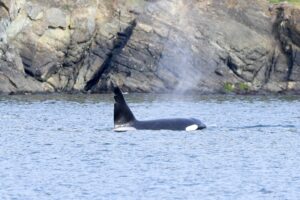
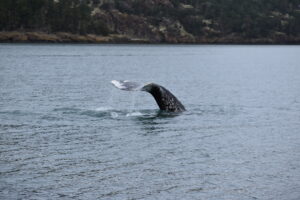
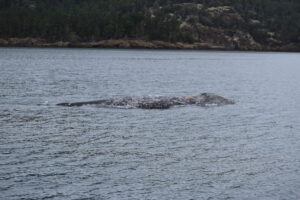
Summer
Truly, there is no summer on earth like a Pacific Northwest summer! The lush green of our dense and rugged coastal forests, the warm, salty breeze, and the extended daylight hours make for a spectacular and unforgettable time on the water. Daily sightings of Bigg’s killer whales continue to increase from spring as more boats and more eyes get out on and near the water looking for that quintessential tall, black dorsal fin cutting through the water. Last year, Bigg’s killer whales were confirmed in the Salish Sea on every single day in June, July and August! However, one of the greatest conservation success stories in the Salish Sea goes by a different name: Humpback! A little over 100 years ago, humpbacks were extirpated (driven locally extinct) from the Salish Sea due to the whaling industry. For nearly a century a humpback whale hadn’t been seen in our inland waters, until the fateful day in 1997 when a single humpback whale was spotted near Race Rocks in Canada. This whale returned again in 1999 and then with a calf in 2003. More and more humpback whales began to come into the Salish Sea to feed over the course of the summer and thus, the “Humpback Comeback” had begun! Now, this area boasts an impressive 800+ humpback whales that return in the summertime to feed and fatten up before their migration back to Hawai’i and/ or México for the winter.
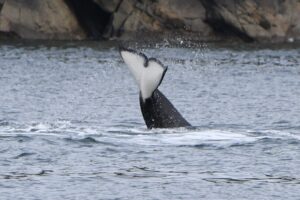
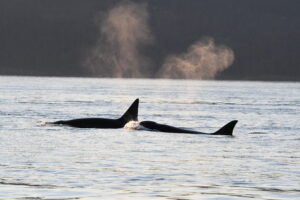
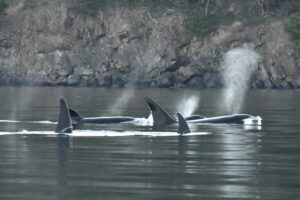
Autumn
There is still a warm breath of summer in the air as days begin to get shorter and leaves begin to get crispy as they change color and fall. With the departure of the large baleen whales (grays, humpbacks, and minkes) it is truly the orcas’ time to shine! The Bigg’s killer whales are still very much active in the autumn with their steady diet of harbor seals and harbor porpoises. The large “game” begins to arrive again in the form of the Steller sea lion and it is an unforgettable spectacle when you are lucky enough to view the top ocean predators go full hunt mode when in pursuit of a Steller! Southern Resident killer whales are also active in Puget Sound as they take advantage of Fall chum salmon runs in the southern end of the Salish Sea.
In addition to the killer whales, fall can be the best time to see Humpback whales! While the summer is also a great time to see Humpbacks, often the fall is when we get more and more of these whales working their way east down the Strait of Juan de Fuca chasing krill and baitfish. There is nothing quite like seeing a lunge-feeding humpback on a sunny fall day!
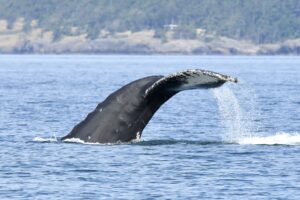
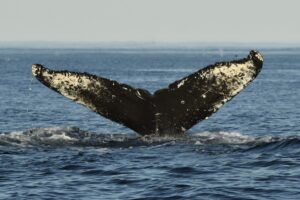
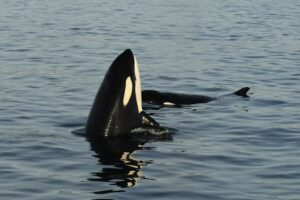
Winter
That time of year in Washington when days are short, cold, and more often than not, wet. But hey, we wouldn’t be called the “Evergreen State” if we didn’t get such consistent, rainy weather patterns! While humans (and some of our terrestrial animal neighbors) might think winter is a great season for packing on the cold-weather pounds and sleeping, some of our aquatic friends are just as active in the area as ever! While sightings are at their lowest in the wintertime, orcas are truly our year-round residents. Local wildlife sightings networks report orcas in the area right through the cold of winter. While this is the time of year that many whale watch operators opt to not go out on the water due to unreliable weather conditions, it doesn’t mean the whales aren’t out there! We also see impressive numbers of Steller sea lions in the wintertime, having come south from their Alaskan rookery (breeding) sites. Steller sea lions are the largest species of sea lion, with males weighing up to 2,500 pounds! The best way to view sea lions and gain an appreciation for their size is when they are hauled out on rocks (or even floating marker buoys) warming themselves and getting ready to dive into the icy waters again to hunt. Another big wintertime draw to the Salish Sea is the great influx of migratory birds to the region. From Harlequin ducks from the Alaskan Arctic, to snow geese from Siberia, to bald eagles taking advantage of fall salmon runs, winter months can truly fly by for the avid birder! So grab your gloves and binoculars for this seasonal spectacle!
We hope this helped answer any questions you might have about our seasons and whales, and we hope to see you on the water soon!

